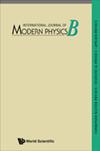定制镁基氢化物作为固态储氢的潜在和可逆材料:第一性原理研究
IF 2.8
4区 物理与天体物理
Q2 PHYSICS, APPLIED
引用次数: 0
摘要
由于氢在地球上的丰富,它是未来绿色能源的一个很有前途的候选者。尽管由于它的不安全性和高爆炸性,它的储存对这个时代的研究人员来说是一个重大挑战。利用DFT框架下的全势线性化增广平面波(FP-LAPW)方法,对XMgH 3([公式:见文],Ba)的结构、光电、热电、振动、热力学性质和储氢能力进行了研究。对镁基金属氢化物钙钛矿SrMgH 3和BaMgH 3的理论研究表明,它们是Pm-3m空间基团中结构稳定的化合物。SrMgH 3和BaMgH 3的优化图反映了最低的基态能量,分别为- 6759[公式:见文]Ry和- 16683[公式:见文]Ry。相比之下,BaMgH 3似乎更稳定。由于零带隙和价带和导带的电子态重叠,电子带结构和态密度表明它们是纯金属的。在100[公式:见文]K ~ 1000[公式:见文]K范围内,BaMgH3的电导率增大到[公式:见文],导热系数增大到[公式:见文],表明BaMgH3具有良好的金属特性。光学分析描述了在可见光范围内的化合物和价壳电子对氢的弱键的吸收,并在一定的光强度下解离氢分子。BaMgH - 3化合物对可见光区的最小散射和最大吸收达到3 eV[公式:见文]。可见区的反射率峰值3.0[公式:见文]eV表明,由于BaMgH 3的不透明性质,40%的光能被吸收。这两种化合物都被认为是热力学稳定的,因为它们的自由能为负,如在1000 K时,SrMgH 3的eV能量为- 1.20[公式:见文本],BaMgH 3的eV能量为- 1.50[公式:见文本]。此外,在对称点显示零虚声子频率的三种声学模式预测了这些化合物的结构和热力学稳定性。SrMgH 3和BaMgH 3的重量储氢浓度分别为2.637%和1.836%。本文章由计算机程序翻译,如有差异,请以英文原文为准。
Tailoring magnesium-based hydrides as potential and reversible materials for solid-state hydrogen storage: A first-principles study
Hydrogen is a promising candidate for green energy sources for future endeavors because of its abundance on Earth. Although its storage is a major challenge for the researchers of this era because of its unsafe and highly explosive nature. The structural, optoelectronic, thermoelectric, vibrational, thermodynamic properties and hydrogen storage capacity of XMgH 3 ([Formula: see text], Ba) are carried out by using the full potential linearized augmented plane wave (FP-LAPW) method in the DFT framework. The theoretical study about these magnesium-based metal hydride perovskites, i.e., SrMgH 3 and BaMgH 3 , declares them structurally stable compounds in space group Pm-3m. The optimization graph for SrMgH 3 and BaMgH 3 reflects the lowest ground state energy, i.e., −6759[Formula: see text]Ry and −16683[Formula: see text]Ry, respectively. Comparatively, BaMgH 3 seems to be more stable. The electronic band structures and density of states declare them pure metallic due to zero band gap and overlapping of electronic states of the valence and the conduction bands. The electrical conductivity of BaMgH3 increases up to [Formula: see text] and thermal conductivity [Formula: see text] in the temperature range 100[Formula: see text]K to 1000[Formula: see text]K revealing the good metallic character of BaMgH 3 . The optical analysis portrays the absorption of compounds in the visible range along with valance shell electrons to the weak bond of hydrogen and dissociates hydrogen molecules at a certain intensity of light. BaMgH 3 compound shows minimum scattering and maximum absorption of light in the visible region up to 3[Formula: see text]eV. The reflectivity peaks in the visible region 3.0[Formula: see text]eV show that 40% of light energy is absorbed due to the opaque nature of BaMgH 3 . Both these compounds are declared thermodynamically stable due to negative free energy such as −1.20[Formula: see text]eV for SrMgH 3 and −1.50[Formula: see text]eV energy for BaMgH 3 at 1000[Formula: see text]K, respectively. Moreover, the three acoustic modes showing zero imaginary phonon frequencies at [Formula: see text] symmetry points predict these compounds’ structural and thermodynamical stability. The gravimetric hydrogen storage concentration of SrMgH 3 and BaMgH 3 is determined as 2.637% and 1.836%, respectively.
求助全文
通过发布文献求助,成功后即可免费获取论文全文。
去求助
来源期刊

International Journal of Modern Physics B
物理-物理:凝聚态物理
CiteScore
3.70
自引率
11.80%
发文量
417
审稿时长
3.1 months
期刊介绍:
Launched in 1987, the International Journal of Modern Physics B covers the most important aspects and the latest developments in Condensed Matter Physics, Statistical Physics, as well as Atomic, Molecular and Optical Physics. A strong emphasis is placed on topics of current interest, such as cold atoms and molecules, new topological materials and phases, and novel low dimensional materials. One unique feature of this journal is its review section which contains articles with permanent research value besides the state-of-the-art research work in the relevant subject areas.
 求助内容:
求助内容: 应助结果提醒方式:
应助结果提醒方式:


